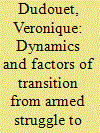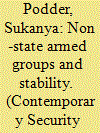|
|
|
Sort Order |
|
|
|
Items / Page
|
|
|
|
|
|
|
| Srl | Item |
| 1 |
ID:
120774


|
|
|
|
|
| Publication |
2013.
|
| Summary/Abstract |
The dynamics of conflict (de)escalation by social movements or political opposition groups have attracted cross-disciplinary interest among social scientists, but there remain several knowledge gaps to be filled. On the one hand, there is already extensive research on the shifts from unarmed expressions of collective grievances to the adoption of violent strategies by oppressed constituencies or 'minorities at risk', as well as on the transition from armed insurgency to negotiations, demobilization, reintegration and conventional politics. However, there is scarce scholarship on the phenomenon of armed groups shifting their conflict-waging strategies from violent to nonviolent means, especially in contexts which cannot be resolved by force but are also 'unripe' for conventional de-escalation methods through negotiation and political integration. This article offers a first attempt to fill this conceptual and empirical gap, by investigating the nature and the drivers of transitions from armed strategies to nonviolent methods of contentious collective action on the part of non-state conflict actors. It focuses in particular on the internal and relational/environmental factors which underpin their decisionmaking process, from a change of leadership and a pragmatic re-evaluation of the goals and means of insurgency, to the search for new local or international allies and the cross-border emulation or diffusion of new repertoires of action. This multilevel analysis draws from past research on various self-determination or revolutionary movements which fit the scope of analysis (i.e. Nepal, Egypt, Palestine, West Papua, East Timor, Mexico and Western Sahara). The article also points to the need for more systematic enquiry on these cases through in-depth comparative empirical analysis.
|
|
|
|
|
|
|
|
|
|
|
|
|
|
|
|
| 2 |
ID:
119247


|
|
|
|
|
| Publication |
2013.
|
| Summary/Abstract |
Events such as the Arab Spring in Tunisia, Egypt, Libya, and Syria have created an urgent need for the international community to engage with a range of armed groups during and after conflict. This engagement extends beyond humanitarian, conflict resolution and counter-terrorism ends to issues of democratization and political transition of such groups in legitimate, stable, and inclusive governments. This article underlines the need to reconsider post-counter-terrorism engagement styles, which frame non-state armed groups (NSAGs) exclusively as spoilers, and stresses opportunities for state-building partnership that certain NSAGs offer. Towards this end, this article emphasizes the importance of distinguishing between different types of NSAGs, based on their sources of legitimacy, resources, reliability, and partnering potential. It concludes with four entry points that promise a strong basis for incorporating 'legitimacy, inclusion, and resource' considerations into the planning and implementation of future state-building efforts.
|
|
|
|
|
|
|
|
|
|
|
|
|
|
|
|
|
|
|
|
|